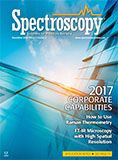Analysis of Metals in Aerosols on Air Filters
Measurement of metals, especially toxic heavy metals, in aerosols on air filters is demonstrated. Simple linear empirical calibration is discussed, and performance is shown for measurement precision and typical detection limits.
Element analysis of aerosols and particulate matter released in smokestacks and other industrial gas discharge is vital to ensure that environmentally acceptable levels of toxic and hazardous elements are released properly into the air. Monitoring smoke or other gaseous waste is important in order to minimize air pollution and the release of toxic metals in compliance with United States Environmental Protection Agency and other world and regional or local governing regulations.
Experimental Conditions Instrument
As a tool to help ensure compliance and proper release, Rigaku offers the NEX DE EDXRF analyzer with 60 kV excitation source and high resolution and throughput Si Drift Detector, providing a fast, simple, yet powerful means for elemental analysis of air filters.
Model: Rigaku NEX DE
X-ray tube: 12 W 60 kV Ag-anode
Detector: High Throughput SDD
Sample Type: Nuclepore(r) polycarbonate Aerosol membranes
Film: Prolene (4 µm)
Analysis Time: 1200 s (300 s per measurement condition)
Environment: Helium (for optimum light element performance)
Autosampler: 10-position 40 mm Automatic Sample Changer

Sample preparation
Air filter material used was Nuclepore polycarbonate aerosol membrane. The filter membrane is supported by a 40 mm diameter plastic outer ring. Samples lie flat and smooth in the 10-position autosampler, covering the analysis aperture.
Calibration
A single-point linear empirical calibration was made for each element using the Standard Value loading levels.
Typical Detection Limits
To determine the Lower Limit of Detection (LLD) using the empirical method, ten repeat analyses of a blank filter membrane sample were measured and the standard deviation calculated. The LLD is then defined as three times the standard deviation. This approach ensures that analyses above the determined LLD are measuring signal above background.
Results
To demonstrate typical measurement recovery and instrument precision, each calibration standard was measured in 10 repeat analyses using a total analysis time of 1200 s (300 s per measurement condition).
Conclusion
The Rigaku NEX DE combines filtered direct excitation with a high performance SDD detector capable of 500,000+ cps throughput to deliver excellent sensitivity for the measurement of metals in aerosols on air filters. The NEX DE analyzer is capable of elemental analysis from Na–U, making the XRF technique ideal for other elements on air filters, as well. For the measurement of light elements Na-Cl, helium purge is used to remove air from the optical path and optimize analysis sensitivity. Elements from Cr and above can be easily measured in air without the need for helium purge.
The NEX DE analyzer also gives the user a very versatile tool not only for monitory air filters, but also elemental analysis of solids, powders and liquids.

Rigaku Corporation
9009 New Trails Drive, The Woodlands, TX 77381
tel. (281) 362-2300, fax (281) 364-3628
Website: www.rigaku.com
